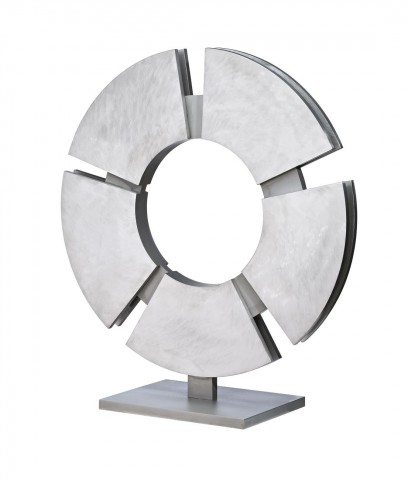STELLAR WHEEL, 2010
INGE KING
stainless steel
71.5 cm height (including base)
signed with initials at base: IK
Private collection, Adelaide, acquired directly from the artist in 2011
Grishin, S., The Art of Inge King Sculptor, 2014, Macmillan Art Publishing, Melbourne, pp. 348, 359, 360 (illus.), 380
In brilliant contrast to Inge King’s expressive and brooding early assemblages (see lot 37), Stellar Wheel, 2010 glimmers with a futuristic presence. An example of King’s final Celestial Rings series, Stellar Wheel is the product of the convergence of many different lines of inquiry in her oeuvre: the circular form, process-driven art making and expressions inspired by new discoveries in science and technology. Created late in life, many of these works reused elements and compositional structures from earlier sculptures. Stellar Wheel itself is closely related to an unpatinated bronze sculpture from 2002 called Capriccio. Both feature flat segments of a circle, arranged in a fragmented mandala radiating from a central void. It was with youthful exuberance that King harnessed her excitement about the dawn of a new century, and the technological progress that would accompany this transition. She translated her excitement into monumental works featuring sacred geometry from which emanated a spiritual energy, describing the series as ’very positive … life affirming works’.1
Recalling her early wall sculptures, the mechanical precision of King’s approach allowed her to explore the inherent qualities of her chosen medium – steel. King chose to use stainless steel for her sculptures of celestial bodies, transforming it into sleek and shiny planes that would convey a movement and lightness in direct contrast to the heavy immobility of their physical reality. ’I use stainless steel to create lightness and floating movement’, she explained.2 The scintillating scoured surface of these steel planes (an effect created with an angle-grinder) evokes the swirling gases and matter of the universe. These surface striations also allowed for a greater range of reflective effects, incorporating the viewer into the artwork, but crucially, also encouraging them to move around it. These seams and marks are the only evidence of human intervention in this construction, functioning in a similar way to the molten beads of steel that clustered along the edges of her structures in the 1960s.
The circular form had been a constant source of artistic inspiration for King since at least the 1970s. With increasingly reduced formal means, King created assemblages that were easily translated into monumental size. The energy that radiates from these works resides in the geometric tension between centrifugal and centripetal forces. The idea of movement, of rotational and cyclical rhythm, is alluded to in King’s title for this work, Stellar Wheel. The angular, interlocking design of each segment of the circular form marries contemporary machine aesthetic with designs reminiscent of ancient Celtic culture. In conjunction with a cosmic theme, the circular form comes to represent the dynamic and demiurgic nature of the universe, echoing the long-lasting presence Inge King created for herself in the landscape of Australian art.
1. The artist quoted in Hurlston, D., and Eckett, J., Constellation, National Gallery of Victoria, Melbourne, 2014
2. The artist quoted in Grishin, S., Inge King Sculptor, Macmillan, Melbourne, 2014, p. 260
LUCIE REEVES-SMITH
